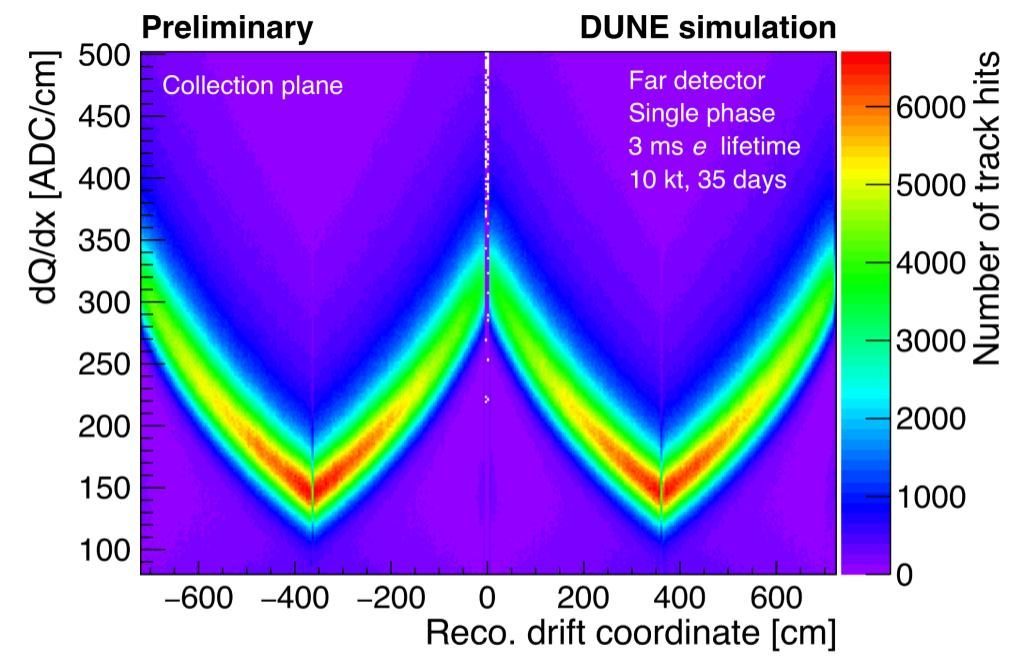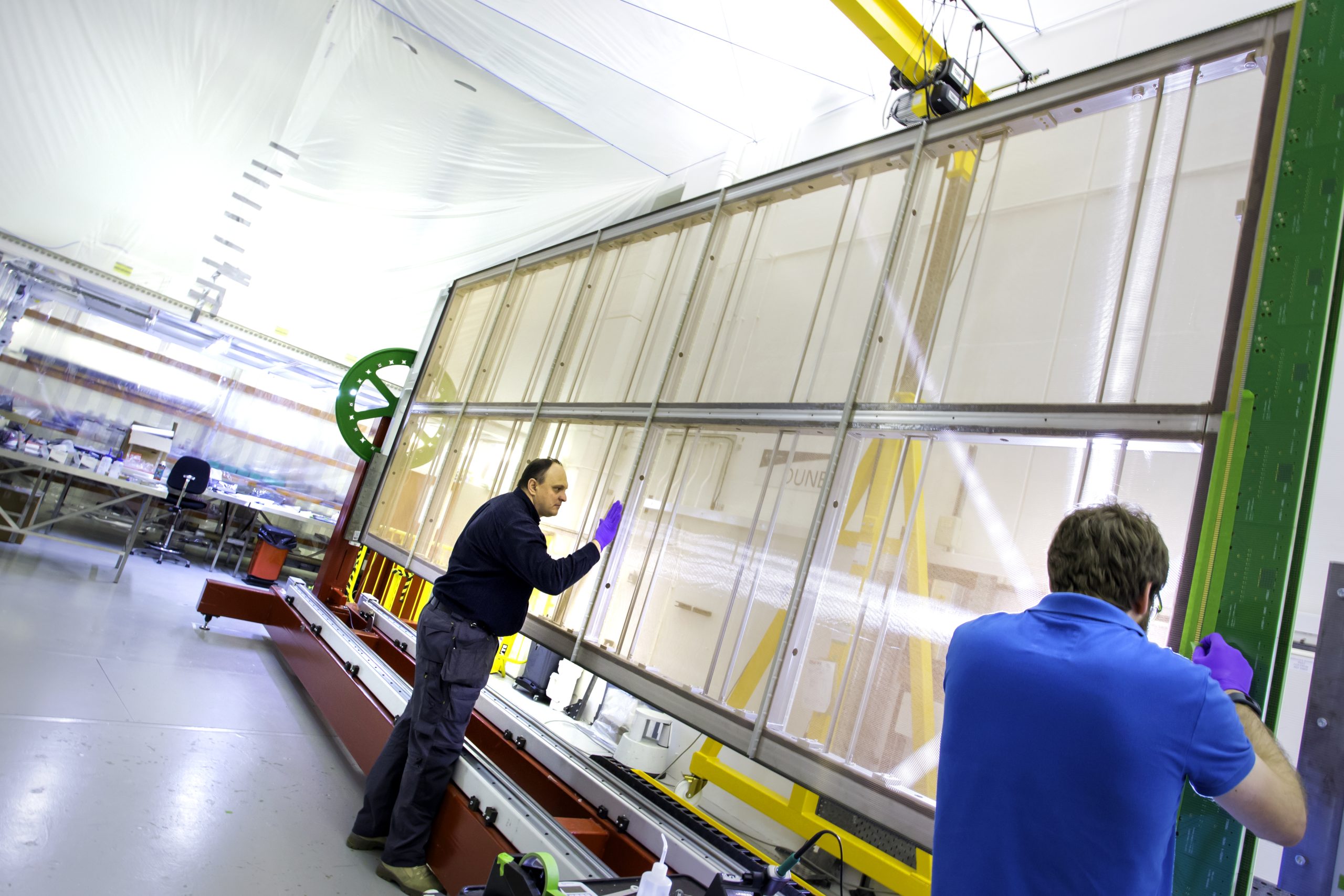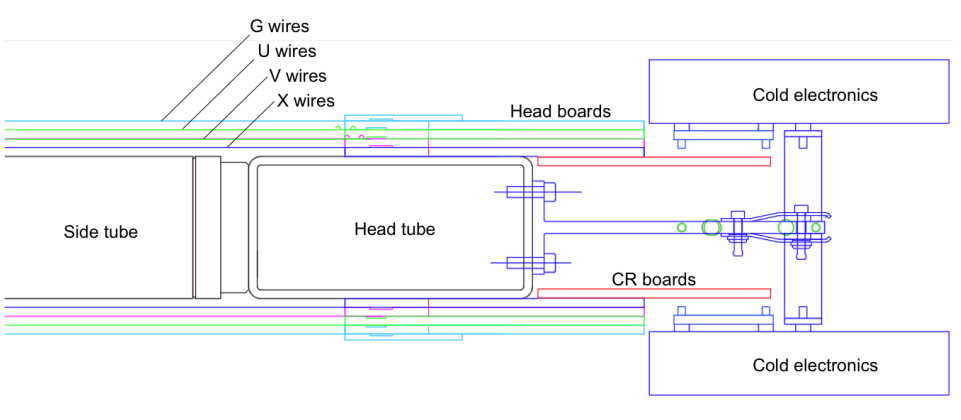UK Involvement
The DUNE UK collaboration effort will deliver detector components that are key to the success of the DUNE project. The main deliverables will be the Data Acquisition System and 150 Anode Plane Assemblies (APAs) for two far detector modules, contributions to the software and computing infrastructure, and the preparation for physics exploitation.
The UK government has invested £65 million in the Deep Underground Neutrino Experiment hosed by Fermilab in the US. Its aim is to study elusive neutrinos in a bid to advance out understanding of the origin and structure of the universe.
As part of this investment, the UK DUNE Collaboration is delivering a series of vital detector components. The components are being built at the science and technology facilities council’s (STFC) Daresbury Laboratory and will be the key to success of the DUNE project. The main deliverables will be the Data Acquisition System and 150 Anode Plane Assemblies (APAs) for two far detector modules, contributions to the software and computing infrastructure, and the preparation for physics exploitation.
The Technology behind DUNE
Computing
DUNE will use the same underlying distributed computing infrastructure and software fabric as the worldwide LHC Computing Grid (WLCG), leveraging the large amount of work done in the LHC era. Led by P. Clarke (University of Edinburgh) DUNE computing will build upon a strong platform of proven infrastructure and expertise. Although computing is not part of the UK pre-construction project, the UK has already established a significant role in several areas and is providing resources to protoDUNE.
Reconstruction software
The UK has a leading role in the development of the LAr-TPC pattern recognition and high level reconstruction software for the Fermilab LAr neutrino programme. Led by J. Marshall (University of Warwick) the UK-led reconstruction tools are critical for the development of the far detector physics programme and the exploitation of the protoDUNE detectors. The goal of the UK reconstruction team is to deliver production-ready reconstruction software for the commissioning and exploitation of the far detector. The pandora pattern recognition will remain the backbone of the UK reconstruction, where a comprehensive programme of algorithm development is planned. The UK reconstruction software suite will also be validated and tuned using the test-beam and cosmic-ray data from the protoDUNE detectors.
Pandora implements advanced algorithms and tools to compare 2D and 3D event topologies, where this functionality will be harnessed to handle the complex multi-GeV neutrino interactions at DUNE.
An advanced iterative procedure will assess the compatibility of 2D clustering from different wire plans, and apply incremental corrections until 3D consistency is achieved. The output will be a full hierarchy of reconstructed particles representing the final-state particles and any subsequent interactions or decays. The development of core pattern recognition algorithms will also harness the unique re-clustering functionality within the pandora framework, in which events can be reconstructed simultaneously under multiple hypotheses and physics-driven metrics then used to select the optimal outcomes.
Calibration with cosmic-ray muons at the DUNE far detector
Owing to the complexity and scale of the DUNE detector systems, many elements of the detector’s response to particle interactions must have dedicated calibration procedures in order to drive-down the systematic uncertainties on our physics measurements and achieve the precision goals of the experiment. Multiple sources of data exist which act as ‘standard candles’ and may aid in the calibration of the DUNE detectors. One such source are cosmic-ray muons, which are produced naturally in our atmosphere and therefore provide a free source of calibration data.
The well-known muon energy loss provides an accurate conversion from the recorded charge (ADC value) to the deposited energy. The drift-dependence of cosmic-ray muon charge depositions is used in the determination of and correction for the finite electron lifetime, the effect of which is shown in the figure below. Similarly, through-going and stopping muons are used to calibrate the rate of recombination, which occurs when ionised electrons recombine with the positively-charged argon ions in the detector. Finally, π0s produced by cosmic-ray muon interactions in the detector provide a standard candle for electromagnetic shower energy calibration, through the calculation of the π0 invariant mass from its decay products.
All procedures defined above are being developed by the DUNE-UK calibration working group led by A. Blake (Lancaster University).

How do we gain findings from the data?
Data Acquisition system
The DUNE data acquisition system for the far and near detectors aims to provide a coherent set of systems across DUNE. It implements a flexible combination of high-speed serial links, ethernet, field programmable gate arrays (FPGAs) and high-end computers. It maximises the use of commercial off-the-shelf (COTS) equipment and standardises around industry protocols. It is in a challenging underground environment, be redundant to guarantee the largest up-time. It needs to be easy to operate and monitor.
The UK is the largest contributor to this system. We contribute to all aspects of the development, including the firmware and software. We also provide almost all the front-out readout hardware and a significant part of the trigger servers for the first two modules
The Data Acquisition System is led by project managers G. Barr (University of Oxford), S. Peeters (University of Sussex) and project engineer D. Cussans (University of Bristol).
Essential Experimental Apparatus
APA Production
The APAs – Anode Plane Assemblies – are the most critical components of the TPC, collecting the ionisation charge and allowing reconstruction of detector activity with mm-scale resolution. The APAs do this by reading out electrical signals of the neutrino interactions. They are huge rectangular planes covered with thousands of copper-beryllium wires, about the width of a human hair. These 6 m x 2.3 m planes, one of which (built in the UK) shown below, have four layers of 150 μm beryllium-copper wire would around them, as illustrated x, v, u and g. The x-layer and g-layer wires are aligned along the longest direction of the APA. The v-layer and u-layer wires are wound at an angle of 35.7° to the x-layer and g-layer.


In between the inner x-layers, a grounding mesh is attached directly to the APA frame. Once installed in the DUNE far detectors, the APAs will hang vertically, in pairs one above another. The wires are read out by cold electronics at the top end of the top APA and the bottom end of the bottom APA.
APA Production plan to build 150 APAs with the help of University partners in the North West at the Daresbury Laboratory. This will be half of the APAs required for the first two 10kt single-phase far-detector modules. The UK factory will be the biggest in the DUNE collaboration; the remaining 150 APAs will be produced at two or three factories in the US.
The UK team members leading this part of the DUNE project; J. Evans (University of Manchester) and A. Grant (Daresbury Laboratory) also led the protoDUNE APA construction project. The team have already demonstrated their ability to deliver by building two APAs for the protoDUNE detector and two for the SBND detector. The UK technical staff have been leading the development of the APA-production procedures, based on protoDUNE experience, to allow mass-production for DUNE. In particular A. Muir (Daresbury Laboratory) and A. Grant have redesigned the winding machine to speed up the wiring process.